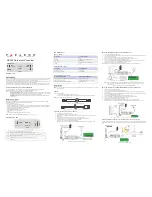
RIGOL
DG900 Programming Guide
2-77
Queries the pulse fall time of the specified channel.
Parameter
Name
Type
Range
Default
[<n>]
Discrete
1|2
1
<seconds>
Real
10 ns to (0.625×pulse width)
20 ns
Remarks
The fall time is defined as the time required for the pulse amplitude to fall from 90% to 10%.
When [:SOURce[<n>]] or [<n>] is omitted, the system sets the related parameters of CH1 by default.
The range of the fall time is limited by the current waveform frequency and pulse width. When the
specified value exceeds the limits, DG900 will adjust the edge time automatically to make it match the
specified pulse width.
Return Format
The query returns the pulse fall time in scientific notation, with 7 effective digits. For example,
3.500000E-08 (the pulse fall time is 35 ns).
Example
:SOUR1:FUNC:PULS:TRAN:TRA 0.000000035 /*Sets the pulse fall time of CH1 to 35 ns.*/
:SOUR1:FUNC:PULS:TRAN:TRA? /*Queries the pulse fall time of CH1 and the query returns
3.500000E-08.*/
[:SOURce[<n>]]:FUNCtion:PULSe:WIDTh
Syntax
[:SOURce[<n>]]:FUNCtion:PULSe:WIDTh {<seconds>|MINimum|MAXimum}
[:SOURce[<n>]]:FUNCtion:PULSe:WIDTh? [MINimum|MAXimum]
Description
Sets the pulse width of the specified channel.
Queries the pulse width of the specified channel.
Parameter
Name
Type
Range
Default
[<n>]
Discrete
1|2
1
<seconds>
Real
16 ns to 999.999 982 118 590 6 ks
500 μs
Remarks
Pulse width is defined as the time from the 50% threshold of a pulse's rising edge to the 50%
threshold of the next falling edge.
The range of the pulse width is limited by the "minimum pulse width" and "pulse period" (for the
ranges of the "minimum pulse width" and "pulse period", please refer to the "Signal Characteristics" of
the "Specifications" in
DG900 Datasheet
). The actual range of the pulse width is
min
min
2
w
pulse
width
w
P
P
P
P
×
−
<
≤
Wherein,
width
P
——pulse width;
min
w
P
——minimum pulse width;
pulse
P
——pulse period.
When [:SOURce[<n>]] or [<n>] is omitted, the system sets the related parameters of CH1 by default.
Return Format
The query returns the pulse width in scientific notation, with 7 effective digits. For example, 1.000000E-02
(the pulse width is 10 ms, i.g. 0.01 s).
Summary of Contents for DG952
Page 2: ......
Page 168: ......
Page 181: ...Chapter 4 Programming Examples RIGOL DG900 Programming Guide 4 7 ...
Page 185: ...Chapter 4 Programming Examples RIGOL DG900 Programming Guide 4 11 ...
Page 187: ...Chapter 4 Programming Examples RIGOL DG900 Programming Guide 4 13 ...
Page 199: ...Chapter 4 Programming Examples RIGOL DG900 Programming Guide 4 25 ...
Page 200: ......
















































